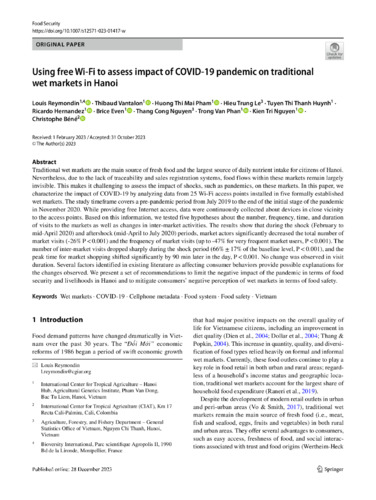Using free Wi-Fi to assess impact of COVID-19 pandemic on traditional wet markets in Hanoi
Traditional wet markets are the main source of fresh food and the largest source of daily nutrient intake for citizens of Hanoi. Nevertheless, due to the lack of traceability and sales registration systems, food flows within these markets remain largely invisible. This makes it challenging to assess the impact of shocks, such as pandemics, on these markets. In this paper, we characterize the impact of COVID-19 by analyzing data from 25 Wi-Fi access points installed in five formally established wet markets. The study timeframe covers a pre-pandemic period from July 2019 to the end of the initial stage of the pandemic in November 2020. While providing free Internet access, data were continuously collected about devices in close vicinity to the access points. Based on this information, we tested five hypotheses about the number, frequency, time, and duration of visits to the markets as well as changes in inter-market activities. The results show that during the shock (February to mid-April 2020) and aftershock (mid-April to July 2020) periods, market actors significantly decreased the total number of market visits (-26% P < 0.001) and the frequency of market visits (up to -47% for very frequent market users, P < 0.001). The number of inter-market visits dropped sharply during the shock period (66% $$\pm$$ <mml:math xmlns:mml="http://www.w3.org/1998/Math/MathML"> <mml:mo>±</mml:mo> </mml:math> 17% of the baseline level, P < 0.001), and the peak time for market shopping shifted significantly by 90 min later in the day, P < 0.001. No change was observed in visit duration. Several factors identified in existing literature as affecting consumer behaviors provide possible explanations for the changes observed. We present a set of recommendations to limit the negative impact of the pandemic in terms of food security and livelihoods in Hanoi and to mitigate consumers’ negative perception of wet markets in terms of food safety.

